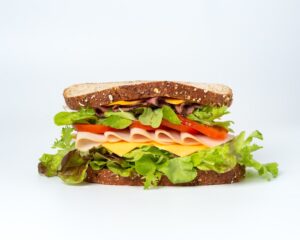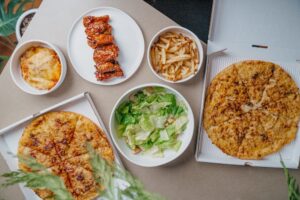
There is much commentary and a growing catalogue of research pertaining to UPFs (ultra-processed foods)… and rightly so, because they are a scourge on human health. They are precursors to many causes of dysfunction in the body’s systems and a range of diseases.
The following article, written by Rachel Dixon of the Guardian (September 2023), is a compilation of the main factors we all need to be aware of. Although we think the article is a very good starting place for understanding and discussing the issues, we don’t believe it to be a definitive piece, because the complexity of nutrition and the need for looking at things through the lens of biochemical individuality, means that we do have to cross reference this kind of information with other data, so as not to be too fixed and dogmatic in our understanding.
What is ultra-processed food?
Almost all food is processed to some extent. Even if you cook from scratch, you probably use, say, flour, olive oil and tinned tomatoes, none of which are in their raw states. But ultra-processed food (UPF) is very different. It contains industrial substances that you won’t find in your kitchen, along with additives to make them taste good. In his bestselling book, Ultra-Processed People, Chris van Tulleken quotes the Brazilian scientist Fernanda Rauber as saying: “Most UPF is not food. It’s an industrially produced edible substance.”
Sounds disgusting! It’s unhealthy, too, isn’t it?
Actually, UPF often tastes delicious. But unfortunately, two recent large studies showed that it significantly raises the risk of high blood pressure, heart disease, heart attacks and strokes. These studies are just the latest in a growing body of research that shows how harmful UPF is to health. Van Tulleken, who is also an infectious diseases doctor at the Hospital for Tropical Diseases in London, cites research showing that a high consumption of UPF is linked to obesity, cancer, type 2 diabetes, depression, dementia and tooth decay, among other conditions. (A study published in 2019 found that 57% of the average UK diet is made up of UPF; among children and poorer people, it can be as high as 80%.) An interesting case in point is that fresh fruit and nuts are not ultra-processed, but muesli often contains a flavour enhancer.
How do I know if I’m eating UPF?
There are no health warnings on UPF in the UK – yet. But there are lots of red flags that may point to UPFs, says Van Tulleken. Does it contain at least one ingredient you don’t recognise? Does it have a health claim on the packet, such as “high in fibre” or “source of protein”? Does it contain palm oil? Is it made by a multinational company? Did that company start with a cheap crop, such as a lentil, and turn it into an expensive crisp, chip or puff? These are all hallmarks of UPFs.
What exactly should I look for on the label?
Carlos A Monteiro, a professor of nutrition and public health at the University of São Paulo, has written a useful guide. According to his journal article, Ultra-processed foods: what they are and how to identify them, food substances not used in home kitchens tend to appear at the beginning or in the middle of the ingredients list (ingredients are listed in order of weight). These include protein sources (hydrolysed proteins, soya protein isolate, gluten, casein, whey protein, mechanically separated meat); sugars (fructose, high-fructose corn syrup, fruit juice concentrates, invert sugar, maltodextrin, dextrose, lactose); soluble or insoluble fibre; and modified oils (hydrogenated or interesterified oil).
Additives appear at the end of the ingredients list. Cosmetic additives, used to make the final product more palatable or more appealing, include flavours, flavour enhancers, colours, emulsifiers, emulsifying salts, sweeteners, thickeners, and anti-foaming, bulking, carbonating, foaming, gelling and glazing agents.
One caveat: some ingredients may sound unfamiliar to the layperson but don’t signify UPF. For example, UK flour is routinely fortified with calcium, iron, thiamine and niacin; ascorbic acid is another name for vitamin C; and corn starch is a traditional, non-UPF thickener (unlike “modified starches”).
I don’t have time to read every label in the supermarket!
A handy, free resource is the Open Food Facts app. This app, by a non-profit organisation based in France, with contributions from tens of thousands of volunteers, lets you search for products and scan barcodes to identify UPFs. So far, the database contains more than 3m products.
What foods are definitely not UPF?
In the Nova food classification system, devised by Monteiro, category one is “unprocessed or minimally processed food”. This includes fresh, frozen and dried fruit and vegetables; milk and plain yoghurt; fresh meat and fish; grains and legumes; fungi; eggs; flour; nuts and seeds; herbs and spices; pasta and couscous. Category two covers “processed culinary ingredients”. This includes things such as butter and vegetable oils; honey and maple syrup; and sugar, salt and vinegar. Category three is “processed foods”. These include freshly made bread and cheese; tinned food – vegetables, fish, fruit; cured meats and smoked fish; and salted or sugared nuts and seeds.
And what almost certainly is UPF?
Top offenders in category four, ultra-processed foods, include fizzy drinks; packaged snacks; sweets and chocolate; ice-cream; biscuits, cakes and pastries; sausages and burgers; packaged pies and pizzas; and chicken nuggets.
But surely no one thinks these are health foods?
True. But the UPF category also includes most bread; breakfast cereal and cereal bars; flavoured yoghurts; fruit drinks; milk drinks; “diet” products; and baby food. Van Tulleken estimates that more than 95% of supermarket bread – including healthy-sounding multiseed loaves or sourdough – is made by the industrial “Chorleywood method”, which has a short proving time and a cocktail of additives and “processing aids”. Even virtuous muesli often contains barley malt extract, a flavour enhancer.
Is there any convenience food that isn’t UPF?
Plenty! Non-UPF cereals include Ready Brek and Shredded Wheat. Lots of time-saving tins, jars and sachets of food are not UPF, such as plain microwave rice. Some supermarket ready meals, including many lasagnes, are not UPF. Often the organic version of a UPF (baked beans or ketchup, say) will not be ultra-processed – although it will be more expensive. This is not to say that all these foods are necessarily “healthy”, just that they are not ultra-processed. It will always be healthier to make your own lasagne, but lots of us don’t have the time, inclination or skill.
What can I snack on that isn’t UPF?
Van Tulleken snacks on peanuts, apples, carrots and bread with peanut butter or honey. If you would usually have a fruit and nut bar, he suggests buying nuts and dried fruit instead – even the “raw” bars contain flavourings. Plain salted snacks are often non-UPF, whereas flavoured snacks are almost always UPF. For example, he says: “Flavoured Doritos contain additives, flavour enhancers and emulsifiers, which ready-salted crisps don’t.”
I’m a vegan. Am I likely to be eating a lot of UPF?
If you base your diet on fruits, vegetables, pulses, grains and nuts, then you won’t be eating a lot of UPF. Vegan alternatives to meat, including mushrooms, jackfruit, beans and tofu, are not UPF. However, “fake meat” – burgers, sausage, bacon etc – and most vegan cheeses are. With plant milks, if they contain emulsifiers, stabilisers or flavourings, they are UPF.
What about food from sandwich shops, takeaways and restaurants?
Almost every fast-food or sandwich chain includes some UPFs in their range – even those that have an aura of health, such as Pret or Leon. Van Tulleken says it is still possible to shop at such chains and avoid UPFs, by choosing porridge, fruit pots, salad (often without the dressing) and soup, and avoiding sandwiches, wraps and pastries. Chain pubs and restaurants also serve lots of UPFs. The dishes least likely to contain UPFs are “whole foods” such as steak and chips; anything with a coating, batter or sauce, such as scampi, will probably contain emulsifiers. Again, takeaways are extremely likely to serve UPFs. The best bet when eating out or on the go is to choose a family-run, independent business that serves home-cooked food – although, for many people, this option is not available or affordable.

To summarise, if you think it might be UPF …
It probably is. But Van Tulleken says: “Agonising over individual products is less important than your overall diet.”
Can’t I just exercise more to counteract the effects of UPFs?
Exercise is an important part of a healthy lifestyle and has numerous benefits, physical and mental. But you can’t magically get rid of the ill-effects of UPF in the gym, just as you can’t cancel out binge-drinking by going for a run.
Isn’t the focus on UPFs just another kind of fat-shaming?
Not at all – if anything, it’s the opposite. UPF is designed to be overeaten; for some people, it is addictive. Eating it to excess has nothing to do with “willpower” or “greed”. Van Tulleken stresses that he has no moral view on eating or not eating UPF, and has no interest in telling people what to eat or how to lose weight. He would simply like people to know what they are eating and be equipped to make a conscious choice.
The problem is the industrialised food system, not individual consumers. “I resent our food system being so polluted,” he says. “I want UPF to be treated like cigarettes.” He would like to see them heavily taxed, banned from schools and with restrictions on marketing them to children. He suggests an approach similar to that which Chile used with foods high in sugar, salt and fat, putting black labels on them to warn consumers.
What if I want to quit UPFs?
Some people will find it easy to cut right down and just have the occasional chocolate bar or takeaway. Others, such as Van Tulleken, find total abstinence easiest. He recommends spending a week or so finding out as much as you can about UPF, while simultaneously eating as much of it as you like. “You fancy six KFC hot wings? Have nine!” The idea, much like chain-smoking while reading Allen Carr’s Easy Way to Stop Smoking, is that, by the end of the week, you will be disgusted by UPF and won’t want to eat it any more.
I’ve quit – my food bill has trebled and I spend all my time cooking!
Van Tulleken recommends buying or borrowing a good budget cookbook with quick and easy recipes – he likes those by Jack Monroe and Allegra McEvedy. Online resources for thrifty cooks include the Guardian’s budget meals series and BBC Good Food’s budget section. The First Steps Nutrition Trust has easy, healthy recipe ideas aimed at pregnant women, but its “eating well for £4 a day” recipes have universal appeal. Again, this approach won’t work for everyone – people who live in food deserts or don’t have access to cooking facilities may have little choice but to eat UPFs.
It sounds like hard work. What’s one easy change I can make?
Van Tulleken is clear on this one: stop drinking fizzy drinks, even the “diet” versions. “Whether or not fizzy drinks have any calories, they will rot your teeth – and if they have phosphoric acid in them, they will also dissolve your bones,” he says.
Speaking of drinks – is alcohol UPF?
Alcohol doesn’t fit neatly into the Nova classification. Traditionally made beer, wine and cider could be considered processed; spirits and alcopops are ultra-processed. But that doesn’t mean you can knock back the beers. “No amount of alcohol is beneficial to your physical health. Everyone should drink as little alcohol as they possibly can,” says Van Tulleken. “And UPF alcohol is the most dangerous form of UPF.”
Also see: Panorama: Ultra-processed Food and Soil, Soul and Society
